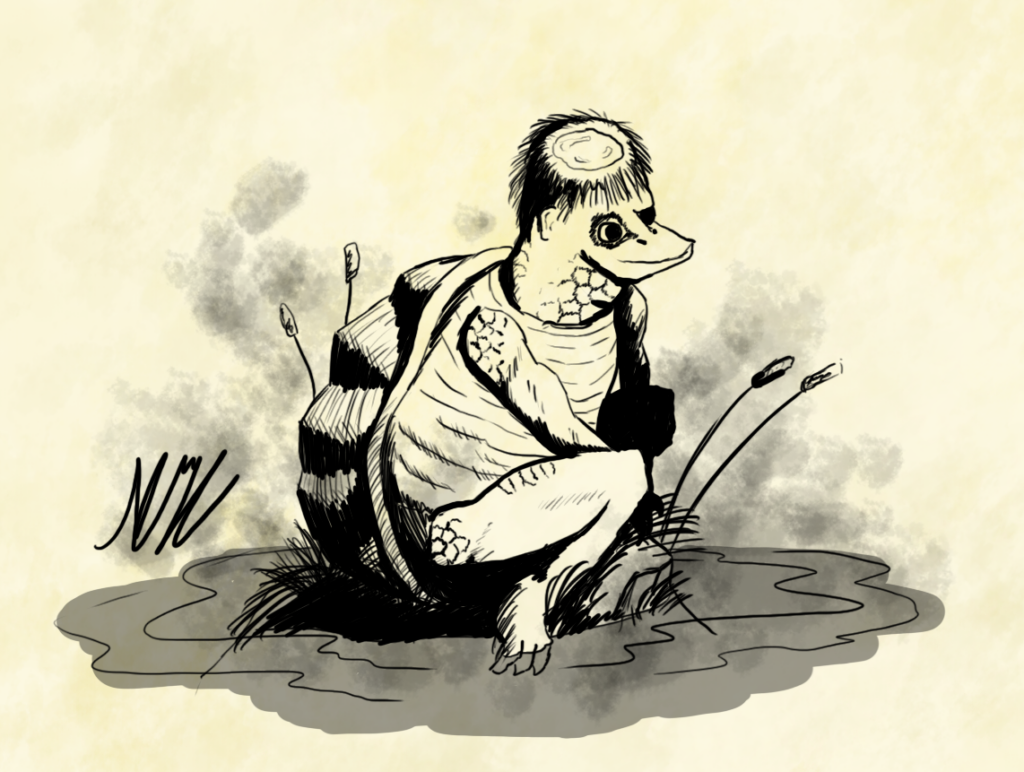Kawatarō / Komahiki / Kawatora / Suiko
The Kappa (also known as Kawatarō, Komahiki, Kawatora, or Suiko) is a mythical creature from Japanese folklore. It is a type of yōkai (supernatural being) that dwells in rivers, ponds, and other bodies of water. The Kappa is both feared and respected in Japanese culture, as it is known for its mischievous, and at times dangerous, behavior. While often depicted as pranksters, Kappa can also be deadly, luring people (especially children) into water to drown them or sucking out their shirikodama, a mythical organ believed to contain a person’s soul or vital essence.


Appearance
- Humanoid but Aquatic:
- The Kappa is usually depicted as a small, humanoid creature, about the size of a child, with features resembling a turtle, frog, or monkey. It typically has a green, scaly or amphibious skin, webbed hands and feet, and a beak-like mouth. Some stories also describe it as having a shell on its back like a turtle, which offers it protection.
- Water Dish on Head:
- One of the Kappa’s most distinctive features is the dish or indentation on top of its head, which holds water from the river or pond where it lives. This water is the source of the Kappa’s strength and vitality. If the water is spilled, the Kappa becomes weak and immobile, losing its power until it can refill the dish.
- Other Features:
- In some stories, Kappa are described as having fish-like scales, while in others, they have a more reptilian or even ape-like appearance. They often have yellow or green skin and an amphibious nature that allows them to live both in water and on land.
Behavior and Folklore
- Prankster Nature:
- Kappa are known for their mischievous and prankster-like behavior. They enjoy playing tricks on humans and animals, such as pulling horses or cows into the water or stealing crops from fields. In rural Japan, people would often attribute mysterious accidents or drownings to the antics of a Kappa.
- Despite their trickster nature, Kappa are also deeply interested in politeness and manners. This characteristic is often used to defeat them—if a person bows deeply to a Kappa, the creature will instinctively bow in return, spilling the water from its head, rendering it powerless.
- Dangerous and Deadly:
- Though they are sometimes portrayed as playful, Kappa can be deadly. In many stories, they are said to drag people, especially children, into the water to drown them. Kappa are also known for their obsession with a person’s shirikodama, a mythical ball thought to contain a person’s soul, located in the anus. They are said to extract this organ, often leading to the victim’s death.
- A Creature of Dual Nature:
- Kappa are also known to help people when treated with respect. In some tales, after being tricked or outsmarted by humans, a Kappa will make a promise or deal to aid the person in return for their life. They are sometimes credited with teaching the art of bone setting or medicine to humans.
- Offerings and Rituals:
- To appease or avoid Kappa, people would often leave offerings such as cucumbers, which are said to be the Kappa’s favorite food. Some families even inscribed their names on cucumbers and threw them into rivers to protect themselves from the creature.
Kappa in Japanese Culture
- Protectors of Water:
- In some stories, Kappa are considered guardians of water and maintain cleanliness in rivers and lakes. Villages near bodies of water would often have shrines dedicated to Kappa in hopes of gaining the creature’s favor and ensuring the health of their water sources.
- Kappa Legends Across Regions:
- The portrayal of Kappa varies across different regions of Japan. In some areas, Kappa are regarded as benevolent water spirits that help with fishing and agriculture, while in others, they are feared as malevolent demons that drown people and steal souls.
- Cucumbers and the Kappa:
- The Kappa’s association with cucumbers is deeply ingrained in Japanese culture. Kappamaki, a type of sushi roll made with cucumber, is named after the creature. In some traditions, throwing cucumbers into rivers was believed to satisfy the Kappa’s appetite and prevent it from attacking humans.
- Kappa in Modern Japan:
- In modern times, the Kappa has become a popular figure in Japanese pop culture and appears in books, cartoons, video games, and movies. Though it is often depicted as a cute or comical character in these contexts, the darker aspects of the Kappa myth still endure, reminding people of the creature’s trickster nature.
Symbolism of the Kappa
- Moral Lessons:
- In many stories, the Kappa serves as a cautionary figure, warning people to respect water and the dangers it poses. It also teaches the importance of manners, as Kappa are obsessed with politeness and will bow in return when greeted with respect.
- Guardian of Nature:
- As a guardian of water, the Kappa represents the connection between humans and the natural world, particularly the rivers and lakes that were so important for survival in ancient Japan. The Kappa embodies the unpredictable and sometimes dangerous power of nature, demanding both respect and caution.
- Trickster and Punisher:
- The Kappa’s role as a trickster aligns it with other yōkai and spirits in Japanese folklore who test or punish humans for arrogance, recklessness, or disrespect. The Kappa’s pranks are often harmless, but when provoked, it can become a deadly adversary.
Variations of the Kappa
- Kawatarō:
- In some regions, the Kappa is referred to as Kawatarō, and it is typically seen as a more benevolent water spirit, helping villagers with agriculture and fishing. Kawatarō is sometimes more gentle and less dangerous than the more mischievous Kappa.
- Komahiki:
- The Komahiki, or “horse puller,” is a version of the Kappa that is known for its habit of dragging horses and cattle into the water. This variation emphasizes the Kappa’s mischievous and troublesome behavior toward farmers and livestock.
- Suiko:
- The Suiko (“water tiger”) is another variant of the Kappa in certain regions of Japan. Suiko is often depicted as more aggressive and dangerous, combining traits of the Kappa with those of a fierce tiger-like creature. It is considered one of the more malevolent forms of Kappa.
Conclusion
The Kappa is one of the most enduring and well-known figures in Japanese folklore, representing both the playful and dangerous aspects of water spirits. As a trickster figure, the Kappa embodies the unpredictability of nature, while also serving as a reminder to respect manners, the environment, and the dangers of water. Despite its mischievous tendencies, the Kappa has become a beloved part of Japanese culture, appearing in everything from ancient legends to modern pop culture, bridging the gap between folklore and everyday life.
Description

The kappa is a Japanese demon or Yōkai living in the waters in traditional Japanese folklore. The name Kappa (河童) literally translates to “river-child”.
It is also known as Kawatarō (川太郎) meaning “river-boy”, Komahiki (駒引) meaning “horse-puller”, Kawatora (川虎) meaning “river-tiger” and Suiko (水虎) meaning “water-tiger”. They also have multiple more regional names such as “Kawappa”, “Kawako”, “Gawappa”, “Kōgo”, “Mizushi”, “Mizuchi”, and “Suitengu” among others. [1]
The kappa is usually depicted as green humanoids [2,3] (sometimes yellow-blue [4]) with webbed hands and feet, scaly or slimy skin. They often carry a turtle shell on their backs [3,5,6]. It has a bowl-like depression on the top of the head called a “sara” or dish. This holds a water which if lost from any means the kappa is either severely weakened or killed. [7]
Otherwise strange physical traits of the kappa is that they possess three anuses and can therefore pass three times as much gas as a human. [8]
They are also sometimes said to have arms that are connected to each other within the shell, meaning that they can slide from one side to the other. [9] Sometimes they are also said to smell like fish. [4]
The kappas traditionally love to eat cucumbers and engage in sumo wrestling. [2]
Behavior
The kappa is generally the size of a human child but is usually stronger than adult males. They live in rivers and ponds and like the warmer months of the year. Usually they live either alone or in families. [8]
In culture they are seen as mischievous trouble makers and tricksters. They are described doing a large variety of misdeeds minor ones being looking up women’s kimonos. Although this is not very harmful they are also described as malevolent and doing things like drowning people and animals, kidnapping children, raping women and sometimes eating human flesh. [7]
Another activity they are described as doing is pulling out a mythical organ called the shirikodama (尻子玉) from the victims anus. The shirikodama is said to be a mystical ball containing the soul. [7,10,11]
Sometimes they befriend humans and other Yōkai. Sometimes they even perform good deeds for friendly humans such as irrigating their land. And as they are highly knowledgeable about medicine they may save humans. According to legend they taught humans the art of bone setting. [7, 12-14] There are also legends that kappa will save friendly humans from drowning.
Offerings are frequently made to the kappa at festivals. These offerings often consist of cucumbers as they are the kappas favorite meal but they may also eat Japanese eggplants, soba noodles, nattō and Japanese pumpkin. [7,15]
Sometimes the kappa may bring fish to humans which is considered to be a good omen. [12]
The kappa is very obsessed with politeness which is one of the main ways to defeat them. If you make a deep bow the kappa is obliged to return the bow spilling the water in its head. [7]
Sources:
[1]: Foster (1998), p. 3, citing Ōno (1994), p. 14
[2]: Foster (2015), p. 157.
[3]: Foster (2015), p. 88.
[4]: Foster (1998), p. 4.
[5]: Frédéric, Louis (2002). “kappa”. Japan Encyclopedia. President and Fellows of Harvard College. p. 480. ISBN978-0-674-00770-3.
[6]: Volker, T. (1975). The Animal in Far Eastern Art and Especially in the Art of the Japanese. p. 110. ISBN978-90-04-04295-7.
[7]: Ashkenazi, Michael (2003). Handbook of Japanese Mythology. ABC-CLIO. pp. 195–196. ISBN978-1-57607-467-1.
[8]: “Kappa | Yokai.com”. Archived from the original on 1 May 2020.
[9]: According to the Wakan Sansai Zue. Foster (1998), p. 6
[10]: “Shirikodama”. tangorin.com. Archived from the original on 2009-12-03.
[11]: Nara, Hiroshi (2007). Inexorable Modernity: Japan’s Grappling with Modernity in the Arts. Lexington Books. p. 33. ISBN978-0-7391-1841-2.
[12]: Foster (1998), p. 8.
[13]: 怪異・妖怪伝承データベース: 河童の教えた中風の薬 [Folktale Data of Strange Phenomena and Yōkai] (in Japanese). International Research Center for Japanese Studies. Archived from the original on 2009-03-04.
[14]: 怪異・妖怪伝承データベース: 河童の秘伝接骨薬 [Folktale Data of Strange Phenomena and Yōkai] (in Japanese). International Research Center for Japanese Studies. Archived from the original on 2011-09-27.
[15]: Foster (1998), p. 5, citing Takeda, Akira [ja] (1988), “Suijinshinkō to kappa 水神信仰と河童 [Water deity belief and the kappa]”; Ōshima, Takehiko ed. Kappa 河童, p. 12.
Author

Josh Morley holds a Bachelor’s degree in Theology from the Trinity School of Theology and a Diploma in Theology from the Bible College of Wales. His academic journey involved interfaith community projects and supporting international students, experiences that shaped his leadership and reflective skills. Now based in Liverpool, Josh is also the founder of Marketing the Change, a digital agency specializing in web design and marketing.
View all posts




